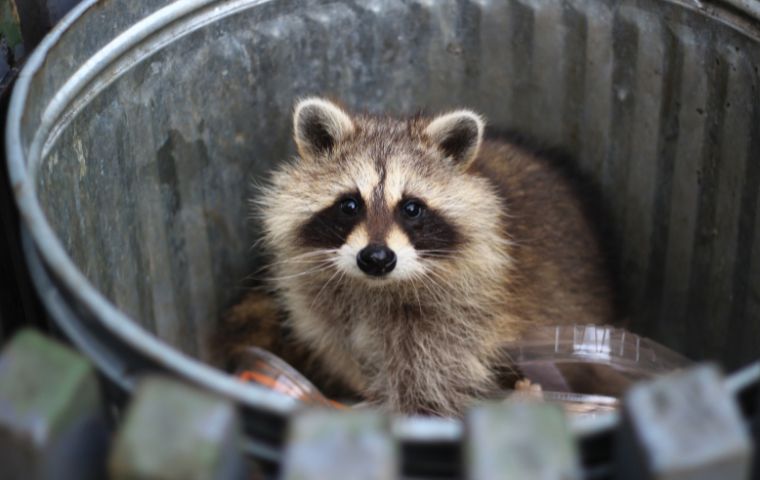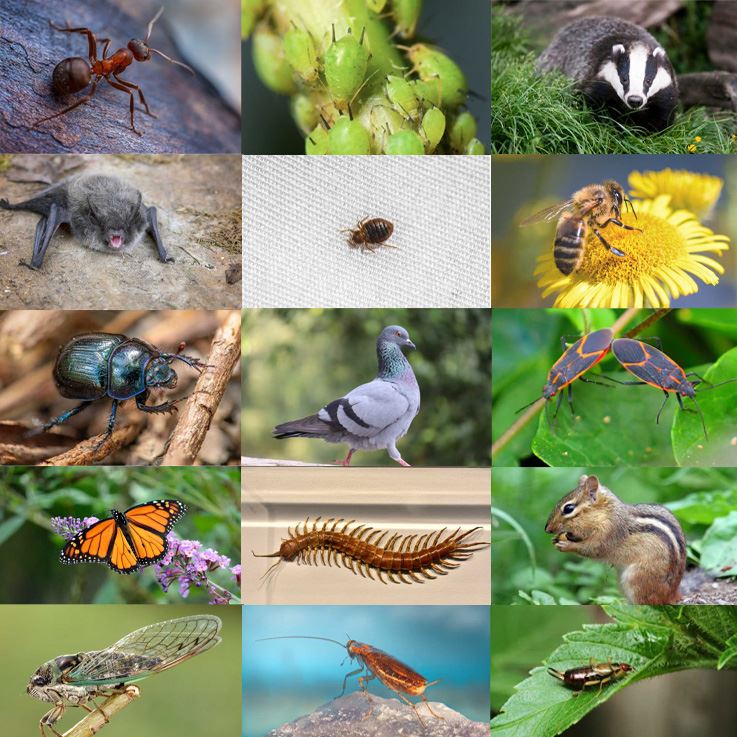
Raccoons
What Are Raccoons?
Raccoons (Procyon lotor) are medium-sized mammals native to North America, known for their distinctive black "mask" of fur around their eyes and their ringed tails. They belong to the Procyonidae family, which also includes coatis and ringtails. Raccoons are highly adaptable and can be found in a variety of environments, including forests, urban areas, and wetlands.
Are Raccoons Harmful?
Raccoons can be considered harmful in several ways, particularly when they come into close contact with human habitats. Their intelligence, dexterity, and adaptability make them capable of causing significant damage and posing health risks. Here are some key concerns:
Property Damage
- Structural Damage: Raccoons often seek shelter in attics, crawl spaces, and chimneys. They can tear through shingles, soffits, vents, and insulation to gain access.
- Chewing Wires: Raccoons may chew on electrical wiring in attics, increasing the risk of house fires.
- Blocking Chimneys & Vents: Nesting raccoons can obstruct chimneys and vents, leading to dangerous carbon monoxide buildup.
- Garden & Lawn Destruction: They dig up lawns searching for grubs and can damage gardens by eating fruits, vegetables, and plants.
- Garbage Raids: Raccoons rummage through trash bins, scattering waste and creating unsanitary conditions.
Health Risks & Disease Transmission
- Rabies: Raccoons are one of the primary carriers of rabies in North America, which can be transmitted to pets or humans through bites.
- Leptospirosis: This bacterial disease spreads through raccoon urine and can contaminate water sources, leading to flu-like symptoms or severe complications in humans.
- Roundworm (Baylisascaris procyonis): Found in raccoon feces, this parasite can cause severe neurological damage if ingested by humans or pets.
- Salmonella & Other Bacteria: Raccoons can carry salmonella, which spreads through their feces and can contaminate food or water sources.
Threats to Pets & Livestock
- Aggressive Behavior: While generally not confrontational, raccoons can become aggressive if cornered or if they feel their young are threatened.
- Pet Food Theft: Raccoons frequently steal pet food left outside, attracting more wildlife and increasing the risk of disease transmission.
- Poultry & Small Animal Attacks: They are known to kill chickens and other small animals in backyard farms by reaching through cages or ripping them open.
While raccoons are a fascinating and intelligent species, their interactions with human environments can create serious problems. Proper prevention, such as securing trash bins, sealing entry points, and avoiding feeding them, can help mitigate these risks.
Raccoon Appearance
Raccoons are medium-sized mammals known for their distinctive appearance. They have a stocky body, measuring about 16 to 28 inches long (not including the tail) and typically weigh between 10 to 30 pounds, though some can grow even larger in urban areas with easy access to food.
- Black “Mask” Around the Eyes: One of the raccoon's most recognizable features is the black fur around its eyes, which resembles a bandit's mask. This marking is thought to help reduce glare and improve night vision.
- Bushy, Ringed Tail: Their tails are long and bushy, typically 8 to 16 inches long, with alternating light and dark rings.
- Grayish Fur: Raccoons have thick, coarse fur that is usually gray, though some may have a brownish or blackish tint. Albino and melanistic (all-black) raccoons exist but are rare.
- Dexterous Front Paws: Their front paws resemble human hands, with five long, flexible fingers. This gives them excellent grip and the ability to open latches, manipulate objects, and even turn doorknobs.
- Short, Sturdy Legs: They have relatively short legs with sharp claws, allowing them to climb trees, fences, and even buildings with ease.
- Pointed Snout and Small Ears: Raccoons have a pointed snout with a keen sense of smell and small, rounded ears that provide excellent hearing.
Raccoons have an unmistakable look, combining their mischievous “masked” face, bushy ringed tail, and agile paws, making them easily recognizable in both urban and wild environments.
Learn more: What Do Raccoons Look Like?
Learn more: What Do Raccoon Droppings Look Like?
Raccoon Habitat
Raccoons are highly adaptable animals found in a wide range of environments, but they are most commonly encountered in the following areas:
Urban & Suburban Areas
- Near Trash Bins & Dumpsters: Raccoons scavenge for food in residential and commercial garbage.
- Attics, Crawl Spaces & Chimneys: They often seek shelter in human structures, particularly in attics and under decks.
- Parks & Golf Courses: These areas provide a mix of natural shelter and human food sources.
Forests & Wooded Areas
- Deciduous & Mixed Forests: Raccoons prefer wooded areas with access to water and plenty of tree cover.
- Near Rivers, Lakes & Wetlands: They rely on water sources for food like frogs, fish, and crustaceans.
Farms & Rural Properties
- Barns & Sheds: Raccoons may seek shelter in outbuildings.
- Cornfields & Gardens: They are notorious for raiding crops, particularly sweet corn.
- Chicken Coops: They often prey on poultry if the enclosures are not secure.
Raccoon Diet
Raccoons are omnivores, meaning they eat both plant and animal matter. Their diet is highly adaptable and varies depending on their habitat and available food sources. Here's a breakdown of what raccoons typically eat:
Natural Diet (In the Wild)
- Fruits & Nuts: Berries, acorns, apples, grapes, persimmons, and other seasonal fruits.
- Insects: Beetles, grasshoppers, caterpillars, and other bugs.
- Small Animals: Frogs, fish, crayfish, rodents, birds, and bird eggs.
- Plants & Vegetation: Corn, roots, seeds, and aquatic plants.
Urban Diet (Near Humans)
- Garbage: Leftovers, pet food, and discarded food scraps.
- Pet Food: Dog and cat food left outside.
- Bird Seed & Suet: They often raid bird feeders.
- Garden Produce: Tomatoes, melons, corn, and other crops.
Raccoons are opportunistic feeders, meaning they eat whatever is available and easiest to access. This is why they thrive in both natural and urban environments.
Learn more: What Do Raccoons Eat?

Raccoon Life Cycle
The life cycle of a raccoon consists of several stages, from birth to adulthood. Their lifespan in the wild typically ranges from 2 to 5 years, but in captivity, they can live up to 20 years due to a lack of predators and better access to food. Here's a breakdown of their life cycle:
Birth & Infant Stage (0-2 Months)
- Gestation Period: About 63-65 days (breeding occurs in late winter to early spring).
- Litter Size: Usually 2-5 kits per litter.
- Newborns: Born blind, deaf, and helpless with light fur.
- Development: Their eyes open at around 3 weeks, and they start to crawl at about 4-5 weeks.
Juvenile Stage (2-6 Months)
- Weaning: Begins at around 7-8 weeks, but they continue nursing for up to 3 months.
- Learning Survival Skills: Kits stay with their mother and learn essential skills like hunting, climbing, and foraging.
- Increased Mobility: By 3 months, they start venturing out of the den but remain dependent on their mother.
Adolescence (6-12 Months)
- Independence Begins: Around 6-8 months, young raccoons begin foraging on their own but may stay with their mother through the first winter.
- Dispersal: Males leave the mother’s territory, while females may remain close.
- Survival Challenges: Many juveniles do not survive their first year due to predators, harsh weather, or human-related dangers (cars, hunting, etc.).
Adulthood & Reproductive Stage (1-3 Years)
- Sexual Maturity: Raccoons become sexually mature at around 10-12 months but often don’t breed until their second year.
- Breeding Season: Typically January to March, with males mating with multiple females.
- Territory Establishment: Males roam widely, while females establish home ranges near their birthplace.
Old Age (3-5+ Years)
- Wild Lifespan: Most raccoons in the wild live 2-5 years due to predation, disease (like distemper or rabies), and human threats (traps, cars).
- Captivity: With proper care, raccoons can live 10-20 years in zoos or as pets.

Hear From Our Happy Customers
-
"Great Communication"
Tech was on time, communication was great, and he accommodated my needs.
- Alonzo W. -
"Very Knowledgeable"
The tech that arrived was courteous, professional, and very knowledgeable. He was Great.
- Uerial I. -
"Professional & Considerate"
I’m pleased with Miche services. Jarvis came today. Professional and considerate. Thank you!
- Judy B. -
"Exceeds Expectations"
I can’t say enough positive things about this company... The tech that came out, Jarvis went above and beyond my expectations. Thank you guys, I will continue using your services.
- Jake M. -
"Wonderful Service"
Wonderful service. Jarvis is great. Took care of everything I needed. Thank you!
- Henry P. -
"Fantastic & Patient"
Jarvis was fantastic and patient. He answered my questions with an in-depth explanation and addressed all of my areas of concern. Would love for him to be my assigned tech going forward. Well done!
- Yonnette M.



